Top page > Chronology and Natural History Group
This group consists of two organizations, "Institute for Space-Environmental Research" and "Nagoya University Museum."
Chronology and Natural History
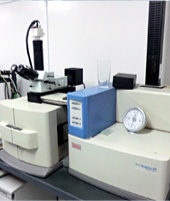
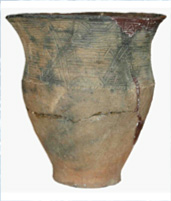
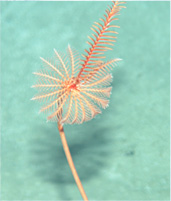
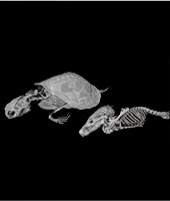
Research Outline of the Institute
The Center for Chronological Research has an ongoing program to analyze the Earth's varied 4,600 million year history by two research groups: the AMS group studying mankind's cultural history and changes in the earth's environment, up to a maximum of about 50,000 years ago, by AMS-14C measurement of archaeological and young geological samples, and the CHIME group leading the world with the development of a method known as CHIME, investigating the long time period between 4,6000 million and 10 million years ago, by CHIME measurement of old geological samples. The Center is in charge of organizing chronological education programs in the graduate school.
Research Contents of the Institute
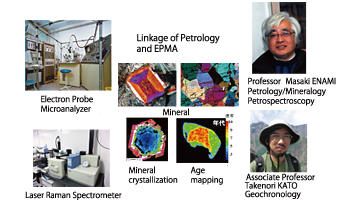
CHIME (Chemical Th-U-total Pb Isochron Method)
The CHIME group performs micron-scale dating of monazite, zircon and other Th- and U-bearing minerals in rocks on the basis of the quantitative EPMA to investigate the long time period between 4,600 million and 10 million years ago.
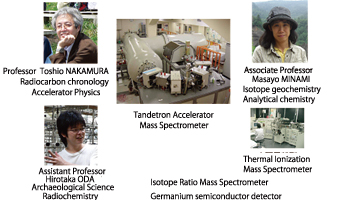
AMS-14C dating
The AMS group performs AMS-14C dating up to about 50,000 years ago on various materials (charcoal, wood, bone, sediment, archaeological materials etc.), and promotes a wide range of research activities in the archaeological, geochemical, environmental and anthropological fields.
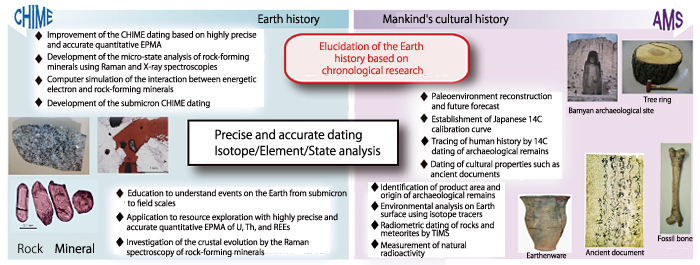
Research in Nagoya University Museum
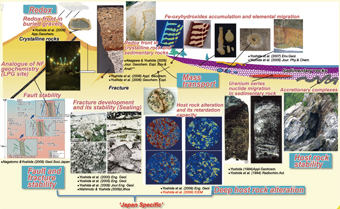
Applied geology, underground research, nuclear
waste disposal
What can studies of the natural world teach us about geological processes operating beneath the earth’s surface? The transport of different elements that occurs during processes such as diagenesis, deep rock alteration, and ore
development is a fascinating research topic that is important for fields such as applied geology, engineering geology, geochemistry and hydrology.
These subjects form the core of the activities in my group, and we focus on what we refer to as Japan Specific aspects that can help develop the techniques needed for nuclear waste disposal
and other relevant usage of the deep geological environment.
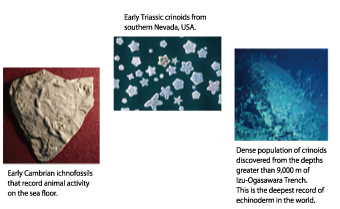
Paleontology based on fossil and modern invertebrate morphology
I conduct research on the (paleo)ecology and evolution of ancient marine invertebrates based primarily on fossil morphology and field data.
1. Paleontonogy and zoology of “living fossils”, especially crinoids (sea lillies) that are currently only known from the deep sea.
2. Ecological interaction and evolution of predator- prey interations. Predation should play an important part in evolution, and I am interested in how this relationship has changed through time based on the fossil record.
3. Cambrian explosion (rapid radiation of marine invertebrates in the Cambrian).
I am also interested in other research projects so long as
research projects so long as
they are mainly based on field data and morphological characteristics.
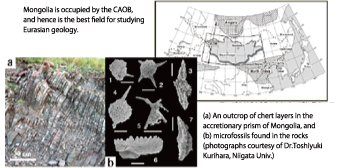
Earth history study / revision of environmental law
I research Earth history science with a focus on field survey. At present my main interest is the construction of the Central Asia Orogenic Belt (CAOB) in Mongolia–one of the worlds great geological structures forming the border region between the Siberian and North China plates. I also conduct geological surveys in the Sør Rondane Mountains in Antarctica to investigate the processes of continental collision between East and West Gondwana. A separate part of the group activities is concerned with environmental pollution in Mongolia. This includes collaboration with legal experts to examine associated legal issues and policy making.
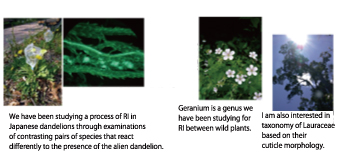
Plant taxonomy and ecology
Reproductive interference (RI)–any negative interspecific interaction during the reproductive process–has been gaining increasing attention due to its potential to help account for the mutually exclusive distribution of closely related species. The question why closely related species rarely coexist has been a mystery since the age of Darwin and RI promises to be a key factor in resolving this mystery. I am studying the details of reproductive interference in several plants including reveal the mechanisms and impacts of RI in plants dandelions and geraniums, trying to reveal the mechanisms and impacts of RI in plants
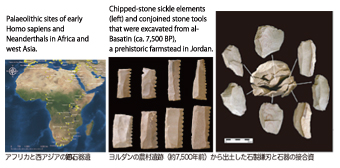
Prehistoric archaeology in west Asia
My archaeological research in west Asia centers on two main themes: human evolution and the origins of agriculture. For the former, I have constructed a database that organizes behavioral records (e.g. tool production technology and ornaments) of early Homo sapiens and Neaderthals from archeological sites in Africa and Eurasia in the time range of ca. 300-20 ka. Research for the latter theme includes analyses of stone tools that were used for harvesting and processing cereals. The analyses focus on morphology, production technology and spatial distribution of these agricultural implements in order to clarify technological behaviors of early farmers and their social organization.
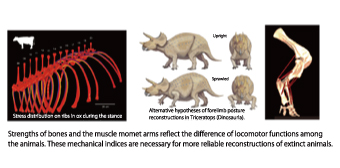
Functional morphology of tetrapod limbs
Since their first appearance on land in the Devonian, tetrapods have diversified to a wide variety of ecospace by changing their locomotor functions on limbs (e.g. cursorial, scansorial, flight, fossorial, and paddling abilities). But, what changes were required in their musculoskeletal morphologies to acquire new locomotor abilities?
To develop a clearer understanding of the relationship between form and locomotor ability among tetrapods, our lab uses a combination of theoretical (musculoskeletal models, stress analysis etc) and experimental techniques (motion analysis) on various extant tetrapods ranging from amphibians to reptiles to mammals. The relationships we observe can then be applied to extinct taxa (e.g. dinosaurs) to reconstruct their locomotor abilities. We recently started a new activity studying functional morphologies of crab claws.

















